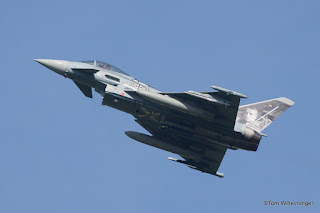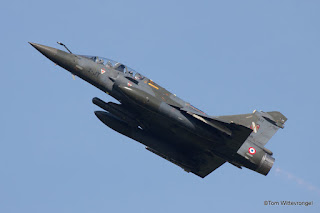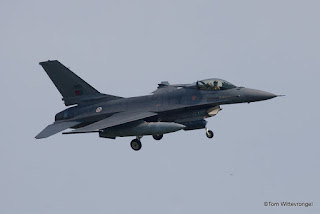Frisian Flag 2017 was again a large scale exercise organized by the Royal Netherlands Air Force between March 27th and April 07th and hosted at Leeuwarden airbase by the 322 TACTES (Tactical Training, Evaluation and Standardization).
The purpose of this exercise is to prepare the various units to a modern conflict or crisis support operation, such as the European Nations are involved in for the moment regarding the worldwide terrorism actions.
The last two decades western nations have been engaged in military operations essentially all over the world and in almost all of them air power played a significant role, sometimes even an autonomous role (Kosovo, Irak, Afghanistan, Lybia or Syria).
The exercise focuses on international cooperation and leadership, with all airspace authorities of Denmark, Germany and the Netherlands working closely together. The Control and Reporting Centre (CRC) has command over the exercise area. Dutch and German military air combat controllers direct the exercise from the Centre. An AWACS radar aircraft from Geilenkirchen NATO Air Base also supports CRC with radar images and on-board air combat controllers.
Operating together also requires training together. During Frisian Flag, training is conducted in large-scale and complicated scenarios, where experienced fighter pilots learn how to plan, develop and execute a mission in a large coalition.
Political demands are great : they want a fast reaction, with minimum assets at minimum cost and avoiding collateral damage. Those are all logical demands but they're high so the trend is to see high demand, high requirement for combat ready air forces to be ready at short notice and effective with minimum fuss and assets. That puts a high strain on training and training requirements, Frisian Flag fulfils that requirement because Frisian Flag provides, at least within Europe, a very unique training opportunity for air forces to train and be able to create these effective combat ready coalition air forces.
If we operate together, we need to train together. That's the Frisian Flag motto and that's what Frisian Flag provides.
To obtain the best results, around 50 aircraft took off from Leeuwarden air base twice a day during the two weeks and the missions had an average of 1.5 hours flight time.
The objectives of Frisian Flag can be listed as follow:
o Provide air and ground crew with realistic training in a modern air combat environment.
o Plan, execute and debrief Large Force Employment missions.
o Practice different roles against a robust threat.
o Integrate with land based forces.
o Promote leadership, initiative and self-discipline.
o Enhance tactics evaluation, validation and development.
o Establish multinational relationships between air forces
In delivering these objectives the missions flown during Frisian Flag range from:
- Defensive protection of ground elements, slow mover or high value assets and integration with Air Defence systems
- Offensive pre-planned strikes (Air Interdiction), Air Superiority (Sweep/Escort), Suppression of Enemy Air Defence (SEAD) and dynamic targeting via Joint Tactical Air Controllers (JTAC) or a combination of both.
Providing a realistic ground based threat environment were a number of nations employing systems such as SA-6 'Gainful' and Roland, the Franco-German mobile short-range surface-to-air missile (SAM) system alongside simulated inflatable targets and 'Smokey Sam' missiles that are fired at aircraft in training situations as simulated SAMs. Ground based Command and Control (C2) for the exercise was provided by Netherlands AF Link 16 networks deployed to Leeuwarden and the Control and Reporting Centre (CRC) at Hachenberg Barracks, Erndtebruck Germany that provided a similar function to that available from the NATO AWACS aircraft.
Employing a 180 NM x 120 NM chunk of airspace off the western coast of The Netherlands, each mission sees a Mission Commander from each unit take his or her turn to plan, develop and execute their specific mission profile. Planning for these missions takes around six hours with flight leads performing the initial planning activity within their specific role culminating in a mass briefing in which all aircrew are required to participate.
The 'Red Air' (bad guys) function throughout the exercise was performed 'in house' and aims to replicate representative threats from potential opponents. The overall mission split of forces averages out at around 70/30 (Blue/Red) for each mission scenario.
The two-week long drills saw the assets split into two teams: the "Red Force", that included the RAF Tornado GR4's and the French Mirage 2000's, and the "Blue Force" made of the Florida and Louisiana ANG F-15's, the German Eurofighter Typhoons, as well as F-16's from Portugal, Belgium and the Netherlands.
Mission durations varied with Red Air being the first elements to get airborne and head to the tankers to 'top off' fuel loads and position themselves in readiness for the imminent engagements as the particular scenario was played out. Post mission and with recovery of all assets complete the mass debrief is conducted with the effectiveness of the session enhanced by extensive use of GPS data downloaded from the pods/trackers carried by each participating aircraft. This data is consolidated and used to reconstruct the conduct of each mission and to validate the effectiveness of each specific sortie.
Given the popularity and growth of Frisian Flag year on year, rumours continue to rumble around that the exercise may be split into separate exercises, in a similar way to Red Flag and Green Flag, but it's too soon to say how this angle will be developed.
Whilst Leeuwarden in the north of the Netherlands, hosted the "tacair"; the supporting tankers, a French Air Force C-135FR, an Italian Air Force KC-767A, a German Air Force A-310MRTT and a RNAF KDC-10 were based at Eindhoven airport in the south. The NATO E-3 AWACS was flying directly from his home base of Geilenkirchen, Germany and a French Air Force E-3D "Sentry" from 2/91 "Bretagne" based at Avord in France.
The purpose of this exercise is to prepare the various units to a modern conflict or crisis support operation, such as the European Nations are involved in for the moment regarding the worldwide terrorism actions.
The last two decades western nations have been engaged in military operations essentially all over the world and in almost all of them air power played a significant role, sometimes even an autonomous role (Kosovo, Irak, Afghanistan, Lybia or Syria).
The exercise focuses on international cooperation and leadership, with all airspace authorities of Denmark, Germany and the Netherlands working closely together. The Control and Reporting Centre (CRC) has command over the exercise area. Dutch and German military air combat controllers direct the exercise from the Centre. An AWACS radar aircraft from Geilenkirchen NATO Air Base also supports CRC with radar images and on-board air combat controllers.
Operating together also requires training together. During Frisian Flag, training is conducted in large-scale and complicated scenarios, where experienced fighter pilots learn how to plan, develop and execute a mission in a large coalition.
Political demands are great : they want a fast reaction, with minimum assets at minimum cost and avoiding collateral damage. Those are all logical demands but they're high so the trend is to see high demand, high requirement for combat ready air forces to be ready at short notice and effective with minimum fuss and assets. That puts a high strain on training and training requirements, Frisian Flag fulfils that requirement because Frisian Flag provides, at least within Europe, a very unique training opportunity for air forces to train and be able to create these effective combat ready coalition air forces.
If we operate together, we need to train together. That's the Frisian Flag motto and that's what Frisian Flag provides.
To obtain the best results, around 50 aircraft took off from Leeuwarden air base twice a day during the two weeks and the missions had an average of 1.5 hours flight time.
The objectives of Frisian Flag can be listed as follow:
o Provide air and ground crew with realistic training in a modern air combat environment.
o Plan, execute and debrief Large Force Employment missions.
o Practice different roles against a robust threat.
o Integrate with land based forces.
o Promote leadership, initiative and self-discipline.
o Enhance tactics evaluation, validation and development.
o Establish multinational relationships between air forces
In delivering these objectives the missions flown during Frisian Flag range from:
- Defensive protection of ground elements, slow mover or high value assets and integration with Air Defence systems
- Offensive pre-planned strikes (Air Interdiction), Air Superiority (Sweep/Escort), Suppression of Enemy Air Defence (SEAD) and dynamic targeting via Joint Tactical Air Controllers (JTAC) or a combination of both.
Providing a realistic ground based threat environment were a number of nations employing systems such as SA-6 'Gainful' and Roland, the Franco-German mobile short-range surface-to-air missile (SAM) system alongside simulated inflatable targets and 'Smokey Sam' missiles that are fired at aircraft in training situations as simulated SAMs. Ground based Command and Control (C2) for the exercise was provided by Netherlands AF Link 16 networks deployed to Leeuwarden and the Control and Reporting Centre (CRC) at Hachenberg Barracks, Erndtebruck Germany that provided a similar function to that available from the NATO AWACS aircraft.
Employing a 180 NM x 120 NM chunk of airspace off the western coast of The Netherlands, each mission sees a Mission Commander from each unit take his or her turn to plan, develop and execute their specific mission profile. Planning for these missions takes around six hours with flight leads performing the initial planning activity within their specific role culminating in a mass briefing in which all aircrew are required to participate.
The 'Red Air' (bad guys) function throughout the exercise was performed 'in house' and aims to replicate representative threats from potential opponents. The overall mission split of forces averages out at around 70/30 (Blue/Red) for each mission scenario.
The two-week long drills saw the assets split into two teams: the "Red Force", that included the RAF Tornado GR4's and the French Mirage 2000's, and the "Blue Force" made of the Florida and Louisiana ANG F-15's, the German Eurofighter Typhoons, as well as F-16's from Portugal, Belgium and the Netherlands.
Mission durations varied with Red Air being the first elements to get airborne and head to the tankers to 'top off' fuel loads and position themselves in readiness for the imminent engagements as the particular scenario was played out. Post mission and with recovery of all assets complete the mass debrief is conducted with the effectiveness of the session enhanced by extensive use of GPS data downloaded from the pods/trackers carried by each participating aircraft. This data is consolidated and used to reconstruct the conduct of each mission and to validate the effectiveness of each specific sortie.
Given the popularity and growth of Frisian Flag year on year, rumours continue to rumble around that the exercise may be split into separate exercises, in a similar way to Red Flag and Green Flag, but it's too soon to say how this angle will be developed.
Whilst Leeuwarden in the north of the Netherlands, hosted the "tacair"; the supporting tankers, a French Air Force C-135FR, an Italian Air Force KC-767A, a German Air Force A-310MRTT and a RNAF KDC-10 were based at Eindhoven airport in the south. The NATO E-3 AWACS was flying directly from his home base of Geilenkirchen, Germany and a French Air Force E-3D "Sentry" from 2/91 "Bretagne" based at Avord in France.















































No comments:
Post a Comment